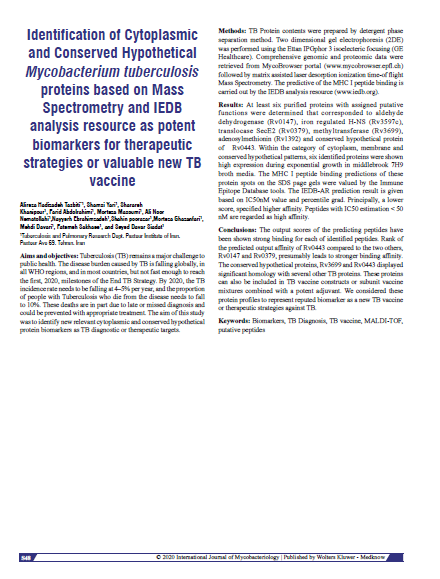International Journal of Mycobacteriology

Aims and objectives: Tuberculosis (TB) remains a major challenge to public health. The disease burden caused by TB is falling globally, in all WHO regions, and in most countries, but not fast enough to reach the first, 2020, milestones of the End TB Strategy. By 2020, the TB incidence rate needs to be falling at 4–5% per year, and the proportion of people with Tuberculosis who die from the disease needs to fall to 10%. These deaths are in part due to late or missed diagnosis and could be prevented with appropriate treatment. The aim of this study was to identify new relevant cytoplasmic and conserved hypothetical protein biomarkers as TB diagnostic or therapeutic targets.
Methods: TB Protein contents were prepared by detergent phase separation method. Two dimensional gel electrophoresis (2DE) was performed using the Ettan IPGphor 3 isoelecteric focusing (GE Healthcare). Comprehensive genomic and proteomic data were retrieved from MycoBrowser portal (www.mycobrowser.epfl.ch) followed by matrix assisted laser desorption ionization time-of flight Mass Spectrometry. The predictive of the MHC I peptide binding is carried out by the IEDB analysis resource (www.iedb.org).
Results: At least six purified proteins with assigned putative functions were determined that corresponded to aldehyde dehydrogenase (Rv0147), iron regulated H-NS (Rv3597c), translocase SecE2 (Rv0379), methyltransferase (Rv3699), adenosylmethionin (Rv1392) and conserved hypothetical protein of Rv0443. Within the category of cytoplasm, membrane and conserved hypothetical patterns, six identified proteins were shown high expression during exponential growth in middlebrook 7H9 broth media. The MHC I peptide binding predictions of these protein spots on the SDS page gels were valued by the Immune Epitope Database tools. The IEDB-AR prediction result is given based on IC50nM value and percentile grad. Principally, a lower score, specified higher affinity. Peptides with IC50 estimation < 50 nM are regarded as high affinity.
Conclusions: The output scores of the predicting peptides have been shown strong binding for each of identified peptides. Rank of the predicted output affinity of Rv0443 compared to the two others, Rv0147 and Rv0379, presumably leads to stronger binding affinity. The conserved hypothetical proteins, Rv3699 and Rv0443 displayed significant homology with several other TB proteins. These proteins can also be included in TB vaccine constructs or subunit vaccine mixtures combined with a potent adjuvant. We considered these protein profiles to represent reputed biomarker as a new TB vaccine or therapeutic strategies against TB.